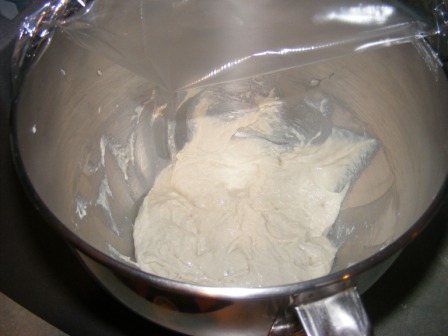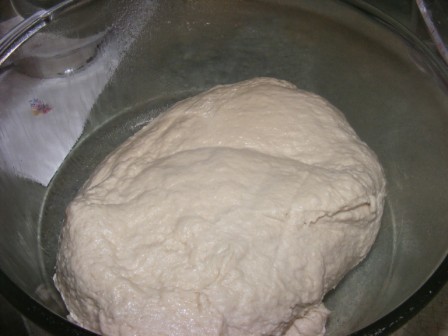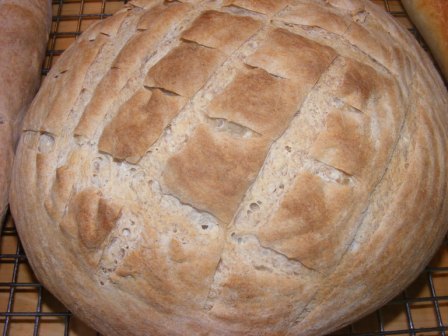As part of the Breads section in the Modern Baker Challenge, I decided to take on French bread. Unlike some recipes that I decide to do because I have never made that particular kind of bread, I chose French bread specifically because I have made French bread before. Lots and lots of French bread.
I’ve been baking French bread since I was about 10 years old and have in recent years really developed a passion for great baguettes. It started with a French bread class I took at the Western Reserve School of Cooking and has continued with my experience on The Fresh Loaf and baking from The Bread Baker’s Apprentice and other artisan bread books and, most recently, Artisan Breads Every Day.
In baking French bread, there are always a few things at odds with each other. First, you want to develop flavor, which takes time. The more time, the better. On the other hand, if you’re like me, you enjoy baking bread but don’t want to be tied down all day making it. That’s why I’ve really taken to some of the new recipes that employ long, slow fermentation in the refrigerator, which develops flavor without much input from the baker. In fact, a lot of the recipes also require very little mixing or kneading, using time to develop gluten, too.
Nick Malgieri’s recipe in The Modern Baker combines new and old methods. There is minimal mixing; time and lots of resting of the dough are used to develop the gluten structure and flavor. Consequently, this recipe takes a long time to make. It is made all in one day and takes about seven hours start to finish. So, on a recent Saturday when I had plenty of time, I decided to try my hand at yet another French bread recipe.
I began by mixing two doughs. The first dough used a true autolyse, as it contained only flour and water, which were minimally mixed and then set aside for an hour to fully hydrate and begin to develop flavor.
The second dough was comprised of flour, salt, water, and yeast. It, too, was mixed just until evenly moistened, then set aside to develop on its own.
After an hour, there was no visible change to the first dough, but the second had smoothed out and begun to rise.
I then combined to two doughs, mixed briefly, let the combined dough rest for 15 minutes, then mixed again for a few minutes. I then set the dough aside to rest for two hours, until it had more than doubled in bulk.
The recipe says to turn the dough out onto the work surface and give it several folds. I left the dough in the bowl and folded it over itself about 20 times with a bench scraper, turning the bowl a quarter turn after each fold. The dough rested for another hour, then I shaped it. I formed two baguettes and a boule. The boule shape is from the next recipe in the book, Pain de Campagne, which I decided to make using the French bread dough.
At this point, the recipe calls for proofing the dough for one to two hours, until it doubles in bulk. I checked my loaves after an hour, and they were more than doubled, so I got them ready to bake by slashing the baguettes and scoring the Pain de Campagne loaf.
Now I had a decision to make. The recipe says to bake the loaves at 425° F for a total of 25-30 minutes. I knew from my baguette-baking experience that the oven temperature was too cool and the loaves wouldn’t achieve the caramelization that I’ve come to expect from my French bread. But I usually try to follow a new recipe as written the first time I bake it, so I set the oven to 425° and hoped for the best.
I pushed the loaves to the 30-minute mark, until I knew the crumb was fully baked and would begin to toughen if I left the bread in the oven much longer. However, the loaves never caramelized like I wanted. They didn’t look bad, as you can see from these photos.
But when compared to the baguettes and Pain de Campagne boule I baked the same day from Artisan Breads Every Day, the lack of caramelization becomes readily apparent.
Although they lacked the crust color and crunch of the Reinhart loaves, the baguettes had beautiful crumb, chewy and full of holes.
My wife liked this bread better than the Reinhart loaves. For me, the crust didn’t quite match up, but the long, slow fermentation and proofing gave the crumb a delicious taste and great texture.
If I bake these loaves again, I will increase the oven temperature to 500° F and probably use steam, too. But otherwise I wouldn’t change the recipe.











Kayte said,
August 1, 2010 at 7:27 pm
Always love to see comparisons. This was one very interesting post…I even learned from the comment sections, and you can bet I am going with the 5 slashes from now on those French baguettes! All your breads always look so professional and wonderful, inside and out. Thanks for tips and suggestions.
Abby said,
August 1, 2010 at 3:45 pm
Wow, the color difference is really fascinating . . . thanks for all of the insights about the process! I will have to try these for comparison . . . my family cares a lot more about taste than color/looks anyway! 😉
gaaarp said,
August 1, 2010 at 4:05 pm
Abby, I’m the only bread snob in my family, so everyone else was fine with the color of these. In fact, my wife liked this bread better than the Reinhart version.
Renee said,
August 1, 2010 at 12:28 pm
Thanks for the great post! Very interesting. The seven hours seems daunting though!
gaaarp said,
August 1, 2010 at 1:52 pm
It’s mostly lag time. Two hour rise here; another hour or two there. There is very little hands-on time.
sallybr said,
August 1, 2010 at 10:43 am
Amazing the difference between the recipes – I also look for a good caramel color in the crust, even if the flavor of the Modern Baker’s ones was good, there is something unappealing about pale bread 🙂
gaaarp said,
August 1, 2010 at 1:53 pm
I agree, which is why I will bake them a la Peter Reinhart if I make this recipe again.
astheroshe said,
August 1, 2010 at 10:24 am
Gaarp..wow..what a difference. I am really surprised about that lack of color. Have you emailed NM to ask for some clarification? ..just curious.
Your Reinhart bread is beautiful…Also I learned in pastry school that 5 slashes is standard on all baguettes ..or the french do not consider it “correct” ( LOL) .. Just some info, hope i am not sounding “”snobbish””.
Thaks for sharing!
gaaarp said,
August 1, 2010 at 1:56 pm
I didn’t e-mail Nick, as the recipe is fairly clear. Based on the time and oven temperature, he is clearly not going for caramelization.
I’ve baked a lot of baguettes, but I don’t think there is any chance of a Frenchman mistaking my loaves for ones from his neighborhood boulangerie. 😉